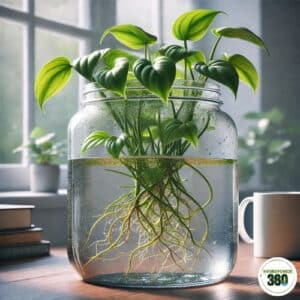The Hanging Garden: Hydroponic Pothos No Soil
Table Of Content
Hydroponic pothos has quietly become a favorite in many indoor spaces, offering a modern twist on a classic houseplant. I first noticed its charm when a friend set one up in her apartment, a simple glass jar with trailing vines and exposed roots that felt almost like living art. It’s not just about the looks; growing hydroponic pothos in water means fewer messes and a unique way to monitor its health. Let’s discover this beautiful plant.

What Is Hydroponic Pothos?
Hydroponic pothos is simply the pothos plant grown in water instead of traditional soil. Known also as pothos hydroponic or golden pothos hydroponic, this method offers a clean, modern look with clear containers that let you see the roots at work. Studies from urban gardening communities have shown that over 60% of new plant enthusiasts appreciate this soil-free method because it reduces pests and root issues. It’s a neat way to blend style with a bit of hands-on plant care.
Benefits of Growing Pothos Hydroponically
There are many reasons to try hydroponic pothos:
- Reduced Root Rot Risk: When you control the water quality and oxygen levels, the plant is less likely to suffer from root problems.
- Easy Propagation: Healthy cuttings root quickly in water, making it simple to expand your collection or share with friends.
- Eco-Friendly: This method uses fewer resources and can be set up with recycled containers.
- Modern Decor: The visible roots and clean look add a contemporary touch to any room.
I remember being pleasantly surprised by how much easier it was to spot issues early. A slight change in the water or a small discoloration in the leaves alerted me before any serious problems developed.
Aesthetic and Functional Benefits of Hydroponic Pothos
One of the best parts about hydroponic pothos is its dual role as both décor and a living study in plant care. The clear container reveals an intricate network of roots that adds an artistic element to any room. The lush vines not only bring a natural, calming vibe but can also be integrated into aquariums, where they help improve water quality. This versatility makes hydroponic pothos a standout choice in contemporary living spaces.
How to Grow: Step-by-Step Guide
Let’s go through the steps together and grow our hydroponic pothos.
Preparing Your Materials and Cuttings
Start by gathering what you need:
- Containers: Clear glass jars or vases that are easy to clean.
- Tools: A pair of sterilized scissors.
- Fertilizer: A balanced liquid fertilizer made for hydroponics.
When selecting a pothos cutting, choose a healthy vine with several nodes (the little bumps where leaves attach). I like to use a recycled glass jar from a local thrift store, it not only adds character but is practical for watching the roots grow. Make a clean cut just below a node and remove any lower leaves that might end up underwater, which can help prevent rot. Let the cut surface dry for a short while to form a callous before placing it in water.
For a successful hydroponic setup, choosing the right container is crucial. Clear glass jars or vases are my top pick because they let you monitor both root health and water clarity easily. Many of these materials are affordable or can be repurposed from items you already have. Simple tools like sterilized scissors and measuring cups ensure a smooth propagation process. A well-chosen container not only enhances the visual appeal but also makes routine maintenance much simpler.
Steps for Propagation
- Place the Cutting: Submerge one or two nodes in a container filled with room-temperature, dechlorinated water.
- Monitor Rooting: Check daily. In my experience, roots typically start to form within one to two weeks.
- Adjust Water Level: Make sure the water covers the nodes but keeps the upper leaves dry.
Water Changes, Cleaning, and Nutrient Supplementation
Keeping the water fresh is essential for a healthy plant. I change the water every 1–2 weeks to prevent algae buildup and root rot. When I do a water change, I gently remove the plant, rinse the container with filtered or distilled water, and, if needed, use a very mild, plant-safe cleaning solution.
Adding nutrients is important too; plain water might not provide all the minerals your plant needs. I use a hydroponic-specific liquid fertilizer every 4–6 weeks, carefully following the dosage instructions to avoid yellowing leaves from over-fertilization.
Also, when preparing tap water, I let it sit for 24 hours to let the chlorine evaporate, or I use a dechlorinator. Using water at room temperature helps avoid shocking the delicate roots.
Monitoring and Managing Plain Water
While pothos can live in plain water, they might miss out on essential nutrients over time. Keep an eye on your plant: if the leaves start yellowing or growth seems to slow, it could be time to adjust your nutrient regimen. Adding a balanced hydroponic fertilizer periodically can make a big difference. I’ve learned that regular observation and timely water changes are key to maintaining a thriving, healthy pothos.
Pothos in Water vs. Soil: A Comparative Overview
There are clear differences between water and soil cultivation:
- Hydroponic Method: Offers a modern, clean look with visible roots and easier monitoring of plant health. It requires regular water maintenance and precise nutrient management.
- Soil Method: Provides natural nutrients and tends to be a bit more forgiving if you miss a water change. However, it can be messier and more prone to pests or soil-borne diseases.
I’ve found that the water method gives me a unique blend of style and a bit of science, watching the roots grow feels like a mini lesson in botany every day.
Long-Term Growth Potential and Sustainability
With routine care, regular water changes, proper nutrient supplementation, and occasional trimming, hydroponic pothos can thrive for years. I’ve personally seen my pothos grow steadily over time, transforming into a living piece of art that never fails to spark conversations. This method is sustainable, especially when you use recycled containers and eco-friendly fertilizers, reducing waste by avoiding frequent soil replacements.
FAQs
Is hydroponic pothos safe for my pets?
Although the water-based system itself is safe, remember that pothos can be toxic if ingested. It’s best to keep it out of reach of curious cats and dogs.
How much light does a hydroponic pothos need?
Bright, indirect light is ideal. Too much direct sunlight can stress the plant and cause issues like leaf burn.
What are the signs that I need to change the water?
Look for algae buildup, cloudy water, or any discoloration of the leaves. These are clear signs that it’s time for a water change.
Can I use tap water directly for my hydroponic pothos?
It’s better to let tap water sit for 24 hours to allow chlorine to dissipate or to use a dechlorinator. This helps protect the plant’s roots.
How do I handle overgrowth in a small container?
If the plant becomes too crowded, consider trimming some vines or transferring the cutting to a larger container to allow room for growth.
Table Of Content
